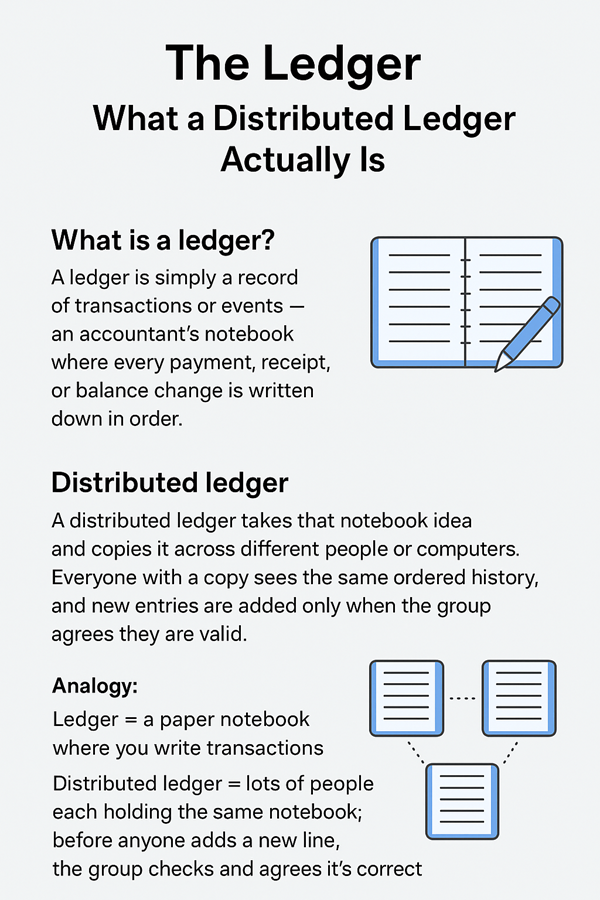The Ledger — What a Distributed Ledger IS
The Ledger — What a Distributed Ledger Actually Is
What this lesson does: Explain, in simple terms, what a distributed ledger is, why it’s described as “immutable recordkeeping,” and how a ledger differs from a traditional database.

Lesson goals (what you’ll learn)
- A plain-English definition of a ledger and a distributed ledger.
- Why distributed ledgers are described as immutable and what that means in practice.
- The key differences between a ledger and a database (how they behave and who controls them).
- Everyday examples to make the ideas stick.
- Short summary and a quick checkpoint to test your understanding.
What is a ledger? — The simple idea
A ledger is simply a record of transactions or events — think of an accountant’s notebook where every payment, receipt, or balance change is written down in order. That notebook’s purpose is to keep the history of who paid what, when, and why.
A distributed ledger takes that notebook idea and makes many identical copies of it, stored across different people or computers. Everyone with a copy sees the same ordered history, and new entries are added only when the group agrees they are valid.
Analogy:
- Ledger = a paper notebook where you write transactions.
- Distributed ledger = lots of people each holding the same notebook; before anyone adds a new line, the group checks and agrees it’s correct.
Immutable recordkeeping — what “immutable” really means
When people say a blockchain or distributed ledger is immutable, they mean the ledger’s past entries are not changed or erased after being recorded.
Important clarifications:
- Immutable ≠ perfect. Immutability means past entries are fixed once written; it does not prevent mistakes at the moment of writing. If someone records bad data, you still have the same unchangeable record of that bad data.
- How corrections happen: Instead of editing an old entry, you create a new entry that corrects or reverses the earlier one (just like writing a new line that says “this reverses the payment recorded earlier”).
Everyday metaphor: If a spreadsheet cell is edited, the old value disappears (mutable). If a ledger is immutable, you can’t change a previous line — you can only add another line that explains or reverses it.
How immutability is achieved (non-technical explanation)
A distributed ledger uses two basic tricks to lock in past records:
- Append-only history: New entries are only added to the end of the ledger. Nobody rewrites old pages.
- Linked records / fingerprints: Each new entry includes a reference (think of a fingerprint or summary) of the previous entry. If someone tried to change an older entry, its fingerprint would change and every later entry would no longer match — the mismatch would be obvious to everyone holding a copy.
So immutability comes from ordering (append-only) plus linking entries so any tampering breaks the chain in plain sight.
Ledger vs Database — the practical differences
| Aspect | Traditional Database | Distributed Ledger |
|---|---|---|
| Control | Centralized (owned/managed by one organization) | Decentralized (many holders/nodes) |
| Editing | Read & write; records can be updated or deleted | Mostly append-only; past entries are not changed |
| Trust model | You trust the central operator (bank, company) | Trust comes from the shared protocol and multiple copies |
| Visibility | Can be private; owner controls access | Public or permissioned; visibility depends on design |
| Performance | Optimized for speed and flexible queries | Often slower for writes because many participants must agree |
| Typical use | Applications that need fast updates, complex queries, frequent edits | Applications that need tamper-evidence, shared truth, audit trails |
Key takeaway: Databases are great when one trusted party controls data and needs flexible edits and fast queries. Distributed ledgers are better when multiple parties need a shared, tamper-evident history and you want to reduce reliance on a single trusted guardian.
Real-world examples (how a ledger is used)
- Bank ledger (traditional): A bank’s internal database tracks accounts and balances; the bank has full control and can change records.
- Cryptocurrency ledger (distributed): Bitcoin’s ledger records every coin transfer across a worldwide network; no single bank can change past transactions.
- Supply chain ledger: Companies record each transfer of goods; multiple participants (maker, shipper, retailer) can verify provenance and timestamps without relying on a single company’s log.
Strengths and limitations — practical perspective
Strengths
- Tamper-evidence: Changes are visible and provable.
- Shared truth: Multiple parties can agree on a single history without a single authority.
- Auditability: Easy to trace the sequence of events.
Limitations
- No perfect garbage collector: Errors get recorded permanently; fixes must be appended, not erased.
- Privacy tradeoffs: Public ledgers are transparent — which can be good for trust but bad for confidentiality. Permissioned ledgers attempt to fix this but reintroduce centralization.
- Performance & cost: Consensus among many copies can make writes slower and more resource-intensive than a single database.
- Entry integrity: A ledger protects history once recorded, but it can’t guarantee the truth of the data that was entered (garbage in, garbage out).
Short quiz / checkpoint (quick self-test)
- In one sentence, how would you explain why a distributed ledger is “append-only”?
- Why might a company prefer a database over a distributed ledger?
- If an incorrect transaction is recorded on an immutable ledger, what’s the typical way to fix it?
(Answers: 1) Because new records are added to the end and old records are not changed. 2) For faster performance, flexible editing, and simpler privacy controls. 3) Add a new transaction that corrects or reverses the error.)
Practical exercise (2 minutes)
Open any note app or paper. Write three simple transactions as if tracking money between friends:
- Alice pays Bob ₹200.
- Bob pays Carol ₹50.
- Alice pays Carol ₹30.
Now imagine the paper is a distributed ledger. Try to “change” the second entry — you can’t erase it. Instead, write a new line: “Correction: Bob actually paid Carol ₹150” and note the timestamp. That’s how corrections happen on immutable ledgers.
Summary — what to remember
- A ledger records events in order; a distributed ledger copies that record across many participants.
- Immutability means past entries aren’t changed; corrections are made with new entries.
- A database is flexible and centrally controlled; a distributed ledger is shared, tamper-evident, and designed for scenarios where multiple parties must have the same trusted record.
- Distributed ledgers are powerful for trust, transparency, and auditability — but they require careful design for privacy, performance, and governance.
What’s next in the course
In the next lesson we’ll look under the hood: “How a Block Is Built” — a non-technical walkthrough of how transactions become blocks, what links blocks together, and why consensus matters. After that we’ll explain different consensus methods, practical deployments, and how smart contracts fit into ledger architectures.
